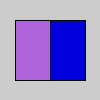| Name | blue |
||
|---|---|---|---|
| Examples |

c = color(175, 100, 220) # Define color 'c' fill(c) # Use color variable 'c' as fill color rect(15, 20, 35, 60) # Draw left rectangle blueValue = blue(c) # Get blue in 'c' println(blueValue) # Prints '220.0' fill(0, 0, blueValue) # Use 'blueValue' in new fill rect(50, 20, 35, 60) # Draw right rectangle | ||
| Description |
Extracts the blue value from a color, scaled to match current colorMode(). The value is always returned as a float, so be careful not to assign it to an int value. The blue() function is easy to use and understand, but it is slower than a technique called bit masking. When working in colorMode(RGB, 255), you can acheive the same results as blue() but with greater speed by using a bit mask to remove the other color components. For example, the following two lines of code are equivalent means of getting the blue value of the color value c: b1 = blue(c); # Simpler, but slower to calculate b2 = c & 0xFF; # Very fast to calculate |
||
| Syntax | blue( | ||
| Parameters |
| ||
| Related |
red green alpha hue saturation brightness rightshift |
Cover
Reference
Tutorials
Bugs
